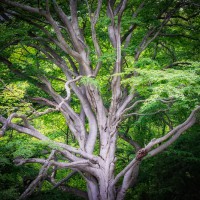SEARCH






|
|
|
|


by Editor Michel Romaggi in collaboration with the author Francis Calderon
Edited and published by Yvette Depaepe, the 29th of May 2024
'Equinox II'
You photograph your models using special scenarios. Each one tells a story. How do you imagine them?
The realization of any project entails weeks of preparations. First the idea appears, usually at night. Then, mentally, I am moulding it, shaping it. I usually take the photograph using a black cardboard background. Each element that composes the image, has been collected from nature and composed of layers using Photoshop. I never replace the fund or employment of third parties. The assembly of "Equinox II" has approximately one hundred layers. For this, it is essential to have a high RAM, free space on the hard drive and a powerful graphics card. The scenarios that appear in most of my works, have a tendency to the low key, probably due to my introverted character.
Can you tell us the story you had in mind to create Equinox II?
To put it somehow without resorting to technicalities, equinox means the beginning of spring, flowering, the flowering of people and living beings. During autumn and winter, we remain in a state of lethargy. The leaves that appear in most of the framing, represent the completion of these two stations of the year so apathetic and the beginning of spring through several butterflies, whose colour is a turning point and optimism in photography.
You are telling us that A.I. is not used. However, the effect on your models is very special. How did you get it?
I am a firm detractor of artificial intelligence. I consider that photography must be as direct and pure as possible. Except for the assembly that I have made, all the elements that are part of the composition, have been extracted from nature itself, previously photographed and inserted in the photograph during the post-production process. Thanks to my good friend Javier Valero, with whom I practice hiking, I can collect from the outside what is necessary for assembly. In the case of 'Equinox II', the leaves that appear in the image, belong to autumn in the forests of my region. It would be much easier and faster to resort to A.I. to create these elements. However, in my opinion, I would consider it a form of deception.
'MUSIC (NO ARTIFICIAL INTELLIGENCE)
Can you tell us the different steps to achieve it?
As said before, first, the idea appears. For days, it stays in my head. If with the passage of time it continues to convince me, I begin with the preparations.
I divide the project into several parts. The first will be the choice of the model, costumes and accessories to use.
Than the documentation is also a very important step, since for a few weeks I try to find information that is related to this idea. Subsequently, I decide what will be the positions that I would like the model to adopt during the session, the background that I am going to use (it is not always black) and the lighting scheme.
The third part will be the preparation of the scene, the photographed elements that I am going to use for assembly and, finally, the interview with the model before the actual shoot.
During this interview I explain what I want to convey in this project. I would like to clarify, that people who appear in my works are usually people without any model training. They are people from my close environment who, normally, have never been photographed in a studio. It is a challenge for both of us, but at the same time, an experience that leaves an essential imprint to both.
'Afrodita VII'
Which equipment do you use? Which settings?
My equipment is composed of two Reflex camera: Canon EOS 5D Mark II and Canon EOS 5D Mark IV, Canon EF 135mm F/2L ISMM and SIGMA EX 50MM F/2.8 HSM, four 300W flash units with different reflectors and a gray card for white balance.
After measuring the light, I make the white balance manually and configure the camera with the following parameters: manual shooting mode, custom white balance, RAW file format, shutter speed, normally, 1/125 second, opening F8 diaphragm, automatic approach, disabled image stabilizer. Because my flashes do not have HS technology (high synchronization), I can't increase the camera shutter speed.
What is your general post-treatment to get this result?
Normally I use the Raw "Acr" interpreter. In ACR I make few adjustments, since having measured the light previously in the study and made the balance of whites manually, both the exposure and the colour temperature are usually correct.
The next step is to open the file with Photoshop. It is very important to have the monitor calibrated. To do this, a colorimeter is essential. I currently use one of the Calibrate brand. The procedure to open it in Photoshop is open, helps me to know what the composition of the final image will be like and then I begin to assemble. I visualize the elements that will compose this assembly with Adobe Bridge, select the appropriate ones and reopen ACR to make some adjustments. The next step is to select them using the specific selection tools that Photoshop has such as polygonal lasso or rapid selection to gradually insert them in the image.
Once the assembly is finished (weeks can pass), I work on the treatment of the skin by separation of frequencies. Once finished, I make the colour adjustments with the following adjustment layers: curves, colour balance, saturation tone, selective correction, etc.
It is very important to work throughout the process with adjustment layers as this is a non-destructive method.
Later, I focus the image with a frequency separation. This method allows me to focus concrete areas of the image. Then I insist on the colour only of certain areas such as cheeks, eyelids, lips and assembly elements, to complete the process using the Dodge and Burn method that provides extraordinary volume in photography. Even though some consider noise as an artistic element, it is unacceptable to me. I rarely use the camera with a sensitivity higher than 100 ISO. It is fascinating to see how the image changes during the post-production process.
'NORTH CHEF (not artificial intelligence)
To end this tutorial, can you tell us about yourself and photography?
I am a passionate photographer with a trajectory of more than twenty years in the world of photography. Since I got my first camera, I knew photography would be my form of expression.
Lover of bass and black background, with a predilection for chiaroscuro, I seek through my goal to highlight the vibrant tones, unique combinations and the most emotional side of people.
I trained as a self-taught artist in different centres in Spain and worked for about a decade in a photo studio. Currently, I have my own studio and combines this job with a sports nutrition establishment.
Throughout my career, I have had the honour of being recognized in many international and national awards. My goal is to show the public a unique experience by creating images that highlight and tell stories full of emotion.
Over time, I found my own voice.
I sincerely thank 1x.com for this opportunity.
 | Write |
 | Cristiano Giani PRO ...a really stunning work. Many congrats... |
 | Francis Calderon PRO Comments like this serve as a balm to continue creating.
I am very happy that you have my work.
Thank you so much Cristiano!! |
 | Miro Susta CREW Dear Francis, after reading the interview I must admit that there is a very hard work behind your photographs.
Even it is not my style they are beautiful, allow me to congratulate you for this interesting and excellent photo (art) work.
Also many thanks to Michel and Yvette for arranging and publishing it. |
 | Yvette Depaepe CREW Thank you, dear Miro! I was astonished too by reading this tutorial. |
 | Francis Calderon PRO I agree that creating this type of work, in my opinion, is hard; However, what is hardest for me is being able to combine it with another professional activity.
Approximately thirty years ago I entered this exciting world of photography and eleven years ago, I embarked on another project: a sports nutrition establishment for the public.
Performing these two professions and giving one hundred percent in each of them is difficult and exhausting.
I greatly appreciate your honest comment Miró. |